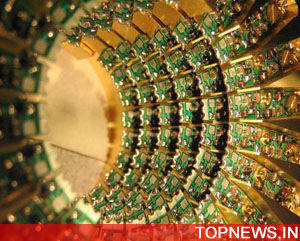Quantum computing comes closer to reality
 London, November 22: Stanford researchers say that they have made a significant advance towards creating quantum computers that will dramatically outshine tradioinal computers in tackling certain key problems like searching large databases, factoring large numbers, creating uncrackable codes, and simulating the atomic structure of materials.
London, November 22: Stanford researchers say that they have made a significant advance towards creating quantum computers that will dramatically outshine tradioinal computers in tackling certain key problems like searching large databases, factoring large numbers, creating uncrackable codes, and simulating the atomic structure of materials.
The researcher say that they have successfully employed ultrafast lasers to set a new speed record for the time it takes to rotate the spin of an individual electron, and confirm the spin''s new position.
They point out that all existing computers — from laptops to supercomputers — see data as bits of information that can be either a zero or a one, but a quantum bit can be both zero and one at the same time.
They say that such a situation, known as a superposition state, allows quantum computers to act like a massively parallel computer in some circumstances, solving problems that are almost impossible for classic computers to handle.
Quantum computing can be accomplished using a property of electrons known as "spin", which can be described as up or down — a variation of the usual zero and one — and may be manipulated from one state to another.
The faster the electrons can be switched, the more quickly numbers can be crunched in a quantum fashion, with its intrinsic advantages over traditional computing designs.
In the Stanford experiment, the qubit, s single unit of quantum information that can be constructed from a single electron spin, was manipulated and measured about 100 times faster than with previous techniques, revealed one of the researchers, David Press, a graduate student in applied physics.
The research was carried out at a temperature of almost absolute zero, inside a strong magnetic field produced by a superconducting magnet.
During the study, the research group first hit the qubit with laser light of specific frequencies to define and measure the electron spin, all within a few nanoseconds, and then they rotated the spin with polarized light pulses in a few tens of picoseconds (a picosecond is one trillionth of a second).
The researchers eventually read out the spin with yet another optical pulse.
Though similar experiments have been conducted in the past, they involved the use of radio-frequency pulses that are slower than laser-light pulses.
"The optics were quite tricky," Nature magazine quoted Press as saying.
In their study report, the researchers revealed that they had to find a single, specific photon emitted from the qubit so as to confirm the spin state of the electron. That photon, however, was clouded in a sea of scattered photons from the lasers themselves, they add.
"The big benefit is to make quantum computing faster," Press said.
The experiment "pushed quantum dots up to speed with other qubit candidate systems to ultimately build a quantum computer."
Press admitted that quantum computers were still years away, adding that in the shorter term, scientists would like to build a system of tens or hundreds of qubits to simulate the operation of a larger quantum system. (ANI)